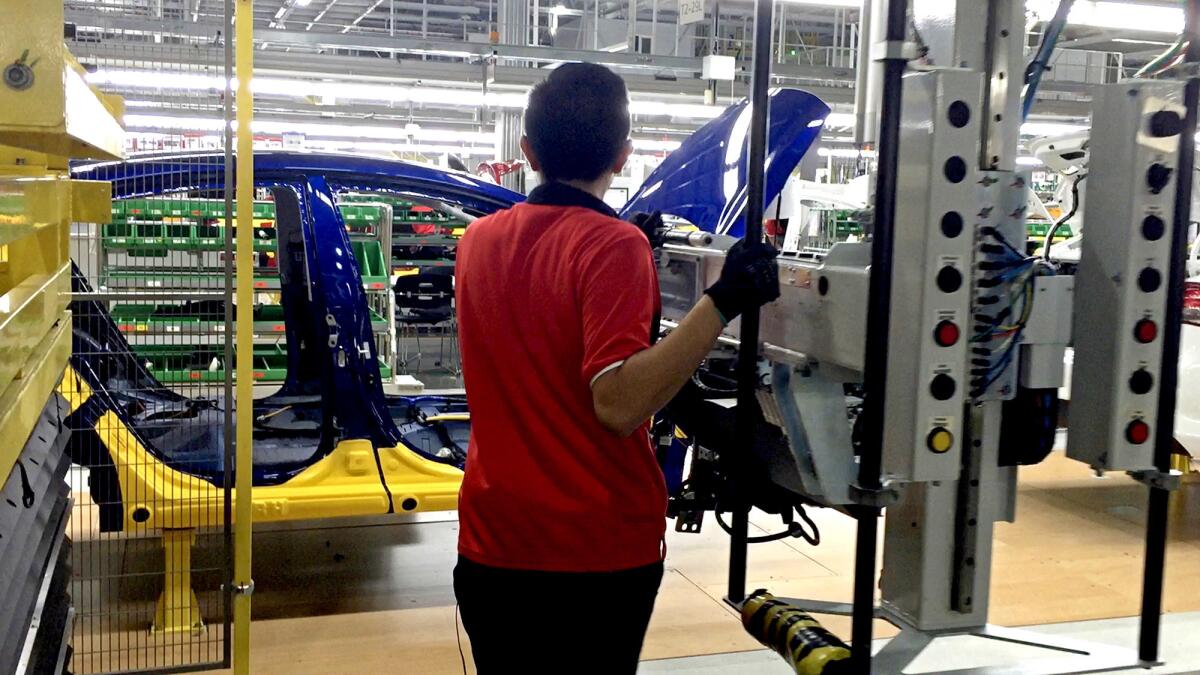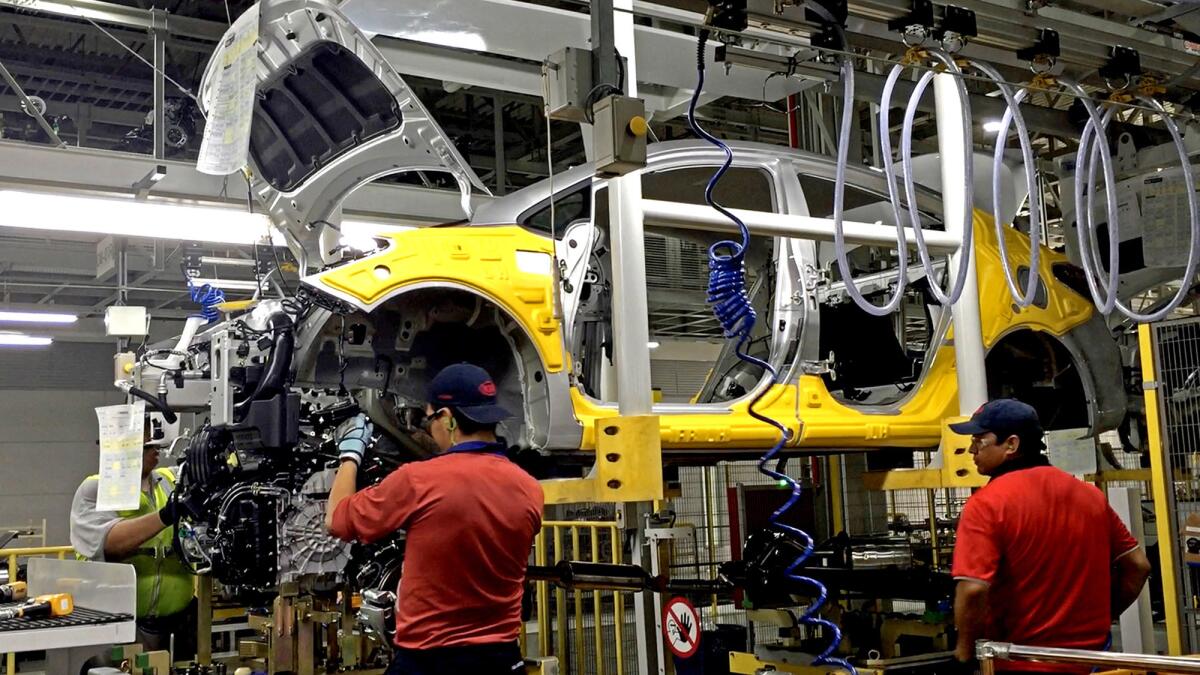A manufacturing boom lifts Mexico — and some U.S. workers, despite trade fears
Enrique Zarate, 19, had spent just a year in college when he landed an apprenticeship at a new BMW facility in San Luis Potosí, Mexico. If he performs well, in a year he’ll win a well-paid position, with benefits, working with robots at the company’s newest plant.
Within a decade or so, most of the BMW 3 series cars that Americans buy will probably come from Mexico, built by people like Zarate.
‚ÄúWhen you start with such little experience, and get such a big salary, it‚Äôs unbelievable,‚ÄĚ says Zarate, whose father is a taxi driver and whose mother is a housewife.
Mexico is in the throes of a manufacturing boom.
Exports from Mexican factories have jumped 13% since 2012. The country already ranks as the seventh-largest producer of cars in the world, and Chrysler, Honda and Volkswagen have major operations there. Over the next five years, another wave of big automakers, including Ford, Audi and Toyota, plan to bring new plants online.
And it’s not just cars. Bombardier, Cessna and Hawker Beechcraft have opened aircraft assembly lines in Queretaro and Chihuahua, Mexico. Plastics and iron and steel exports have steadily risen.
In the process, workers like Zarate are being lifted into the middle class by the thousands.
That sounds like an exported version of the American dream, circa 1965, in places such as Dearborn, Mich., or Marysville, Ohio. Indeed, the influx of those types of jobs to Mexico has enraged Ford employees in Wayne, Mich., and the makers of furnaces in Indianapolis.
Donald Trump called the North American Free Trade Agreement ‚Äúthe worst trade deal in history.‚ÄĚ Bernie Sanders said that an American company moving to Mexico is ‚Äúthe kind of corporate behavior that is destroying the middle class.‚ÄĚ Even Hillary Clinton, who once praised the pact with Mexico, has expressed increasing skepticism about trade deals.
But despite what you might have heard on the presidential campaign trail, Mexico’s manufacturing surge has not been an unalloyed disaster for American workers.
U.S. manufacturing production, it turns out, is rising as well. Factory output has nearly reached its all-time high this year, and is up more than 30% since 2009.

Partly thanks to automation, factory jobs are still way off from their peak of more than 19 million in 1979. But they have been climbing slowly since the end of the Great Recession in 2009. Over the last six years, U.S. manufacturers hired 744,000 new workers, an uptick of 6%.
The bottom line, say economists and company executives, is that what’s good for Mexico’s factory workers is good for some U.S. workers too.
That’s because the chain of goods that supplies Mexico’s factories is very different from the one for China. Simply put, Mexico needs to consume a chunk of U.S. goods in order to make its own.
Around 40 cents of every dollar that the United States imports from Mexico comes from the U.S., compared with just 4 cents of every dollar in Chinese imports, according to the Woodrow Wilson Center. The influx of auto factories in Mexico might sustain hundreds of supplier jobs in Deforest, Wis., or Calhoun, Ga.
‚ÄúInstead of thinking of Mexico as a separate part of production, it‚Äôs now part of our manufacturing process,‚ÄĚ said Raymond Robertson, an economist at Texas A&M University. ‚ÄúMexican companies aren‚Äôt just producing products that rival ours, they are producing parts of our products.‚ÄĚ
The evolution of factory work in the United States, Mexico and China is illustrated by Evco Plastics, a family-owned, Wisconsin-based plastics maker.
Dale Evans, the owner of Evco Plastics, is not ashamed to admit that recently he‚Äôs been hiring more people in Mexico than in Wisconsin ‚ÄĒ or Dongguan, China.
In the last two years, Evco has added 100 people to its three Mexican plants, and has been hiring more slowly in its five U.S. facilities. Meanwhile, the company is shrinking two Chinese plants into one.
But Evans says that being able to give clients the option of getting their plastic parts made in Mexico more cheaply has allowed him to move much of his 500-member staff in Wisconsin and Georgia to higher-skilled tasks, such as programming robots.
‚ÄúThe easy things ‚ÄĒ people picking things up and putting them in boxes ‚ÄĒ that [work] left,‚ÄĚ said Evans. It‚Äôs too expensive for him to employ rote manual laborers in America.
He has instead invested in training his employees to maintain huge, potentially dangerous robots handling plastic parts. ‚ÄúThe difficult things you can do with machinery, that stayed.‚ÄĚ
The shift is driven in part by labor costs.
Evans says he used to pay Chinese workers $1 an hour, but now pays them closer to $3 per hour. In Mexico, he says, he now pays a typical plastics assembler around $4 per hour, which is just a dollar more than what he paid when he first set up shop there in 2001.
‚ÄúIt‚Äôs just gotten cheaper in Mexico,‚ÄĚ Evans said.
One of the workers who has benefited is Tania Berenice Salazar, a 25-year-old from Monterrey. The single mom was working as a cashier earning about $1.60 per hour before she got an entry-level job packing up plastic materials at Evco in 2012.
Now she supervises other packagers and makes about $1.80 per hour, even as the peso has plummeted. That’s significantly above the minimum wage in Mexico of around $4 per day.
‚ÄúI feel that this is a step forward. I am rising, I am not stuck,‚ÄĚ Salazar said.
As she spoke, two nearby plastic injection robots were loudly stamping out pieces of dashboards for Mexican-made Kia sedans and lamp fixtures. The drab Evco factory floor in Monterrey sounds like the inside of a washing machine.

U.S.-supplied raw materials account for 60% of the cost of the plastic incubators and ATV parts the company makes in Mexico. For Evco’s China plant, the figure is just 15%.
Evco’s experience supports the findings of several studies on the effects of NAFTA, which 22 years ago loosened barriers to trade among the U.S., Mexico and Canada.
Whereas China‚Äôs prowess in electronics and textiles appears to have made a lasting dent on U.S. manufacturing ‚ÄĒ costing up to 2.4 million jobs from 1999 to 2011, according to one study ‚ÄĒ trade flows with Mexico have been more balanced.
Multinational manufacturing companies hire an extra 250 U.S. workers for every 100 employees they bring on in Mexico, according to a 2014 study by researchers at the Peterson Institute for International Economics, a nonpartisan organization.
Dean Baker, the co-director of the left-leaning Center for Economic and Policy Research, was an early critic of NAFTA and continues to believe that ‚Äúit put downward pressure on manufacturing wages‚ÄĚ in America.
Still, he acknowledges that the pact had benefits, at least for U.S. corporations.
‚ÄúIt helped the competitive position of our automakers,‚ÄĚ he said. NAFTA was ‚Äúbad, but not as bad for U.S. workers as China.‚ÄĚ
None of that research is any comfort to Frank Staples, who will lose his gig supervising an assembly line when Carrier moves 1,400 furnace-manufacturing jobs from Indianapolis to Monterrey, Mexico, by 2018.
Staples, who has worked at the company for 11 years, blames the move on ‚Äúcorporate greed.‚ÄĚ
‚ÄúI think NAFTA was one of the biggest screw-ups that has ever been put in place,‚ÄĚ he said.
The 37-year-old father of three has been working with his hands ‚ÄĒ in demolition, then in warehouses, and now at Carrier‚Äôs factory ‚ÄĒ since graduating high school two decades ago. Now, for the first time, he‚Äôs genuinely worried about how he‚Äôll support his family.
Staples said that anyone who says trade comes with more pros than cons has no idea what it’s like to be on the losing side of that equation.
‚ÄúPeople can say what they want to say [about trade], but they aren‚Äôt experiencing it firsthand,‚ÄĚ Staples said.
United Technologies, which owns Carrier, says the move reflects ‚Äúthe steady migration of the company‚Äôs competitors and suppliers to Mexico, as well as ongoing cost and pricing pressures driven in part by evolving regulatory requirements.‚ÄĚ The company said it would pay for four years of traditional or technical education for laid-off employees.
The trade pact hit low-skill factory jobs hardest. Many garment manufacturers deserted Los Angeles for border maquiladoras in the 1980s and ’90s. Starting in the 2000s, though, some aircraft builders and carmakers, which were already firing up plants in the U.S. Southeast, followed in earnest.
Today, the United States has a $66-billion trade deficit with Mexico in cars and car parts, according to the National Assn. of Manufacturers.
There are no firm estimates on the total number of jobs that have migrated to Mexico. One study, from a liberal think tank funded by unions, found that a total of 851,700 positions were lost to Mexico in the wake of NAFTA. But several other nonpartisan reports have found that after factoring in jobs created by increased trade, the pact had little to no effect at all on employment.
Some factory work is returning to the United States, but jobs aren’t necessarily following. New generations of robots can do the work faster and more precisely than humans can.
Even in Mexico, with its lower labor costs, machines are replacing people.
At a new Kia factory in Nuevo Leon, Mexico, robots dominate the vast production spaces where the skeletons of Forte compacts take shape. The facility occupies an expanse of arid land that would comfortably accommodate three plants the size of Tesla’s main hub in Fremont, Calif.
In a welding area at the center of the assembly line, more than 300 automated machines work in concert with one another to fuse sedan doors to roofs and attach trunks to bumpers.
The towering robots are fenced off in playpen-like areas; workers rarely interact with them.
Even when people are using their hands to, say, install a car hood, they are actually just guiding a machine holding the steel to the front of the car and pushing it forward until the piece slots in.
‚ÄúIt‚Äôs so he doesn‚Äôt tire his back,‚ÄĚ explained Victor Aleman, a spokesperson for Kia, watching as a welder pushed a massive machine toward the shell of a future Forte. Going forward, virtually all of the Forte sedans and hatchbacks purchased in the United States will be produced at this plant in Mexico, Kia said.
‚ÄúWe are really happy because these workers don‚Äôt complain,‚ÄĚ Aleman said, gesturing toward a sea of yellow robots that help this Kia facility produce a car every 54 seconds.
A Mexican autoworker at the Kia plant earns $3.75 per hour, the company said. A typical auto manufacturer in the United States makes about $40 per hour, according to data from the Bureau of Labor Statistics.
But cheap labor south of the border hasn’t derailed Bernie Degenhardt’s career.
The father of two started working at Evco Plastics headquarters in Deforest, Wis., in 1986, when he was a sophomore in high school. He never left.
Degenhardt began as a machine operator, making about $5.50 an hour plucking plastic parts from an injection molding machine. He quickly realized that the influx of robots onto the factory’s floor might pose a threat.
‚ÄúYou want to be managing the new automation and technology, and not worried about ‚Äėsomething is going to take my job away,‚Äô‚ÄĚ Degenhardt says. So he got an associate degree in electronics, and then in 2006, a bachelor‚Äôs in mechanical engineering.
Today, Degenhardt earns around $120,000 per year as the plant’s automation manager, supervising about 20 people.
At Evco’s Wisconsin plants, robots do the work Degenhardt once did, pulling just-made plastic from its mold.
‚ÄúThe robots do my [old] job, and I am managing people that manage them,‚ÄĚ he says.
Twitter: @NatalieKitro
More to Read
Inside the business of entertainment
The Wide Shot brings you news, analysis and insights on everything from streaming wars to production ‚ÄĒ and what it all means for the future.
You may occasionally receive promotional content from the Los Angeles Times.











